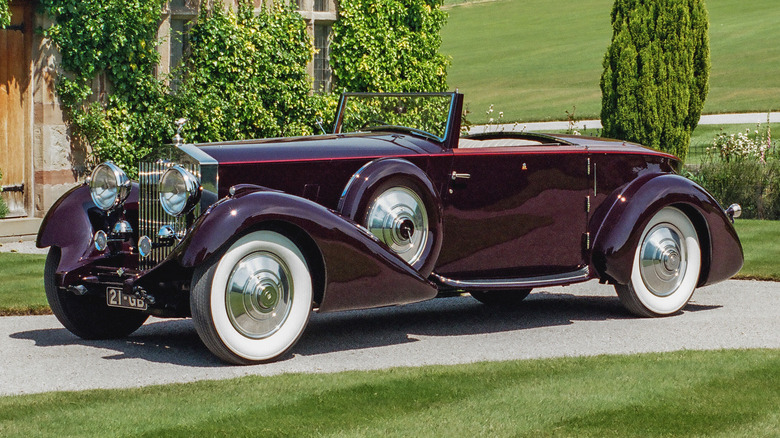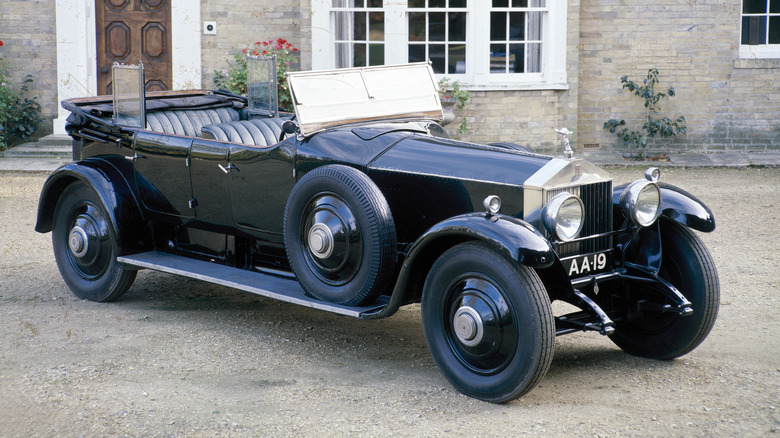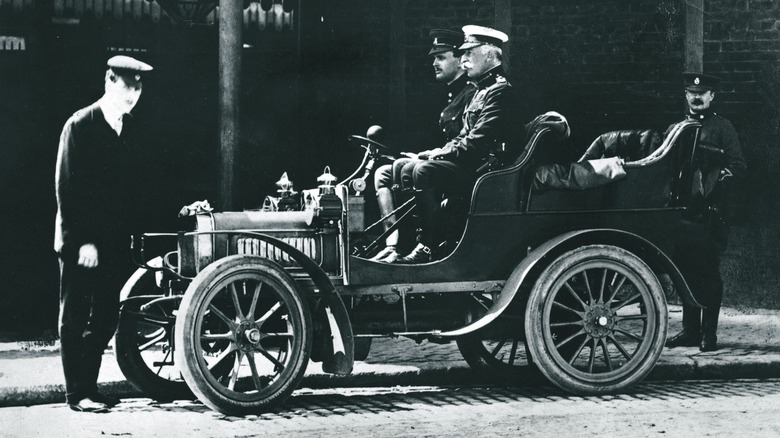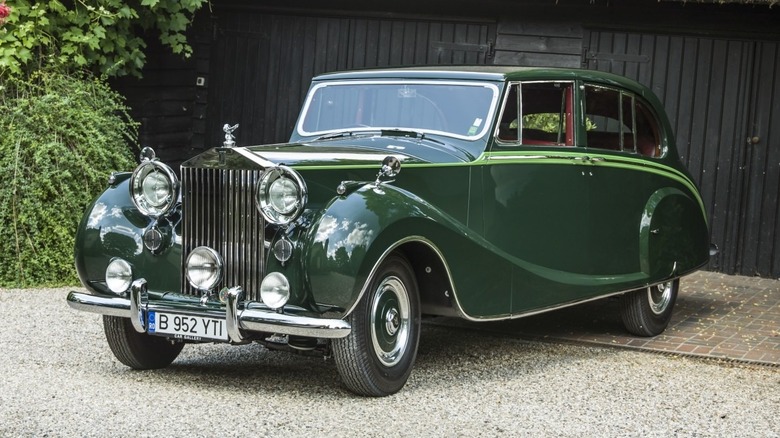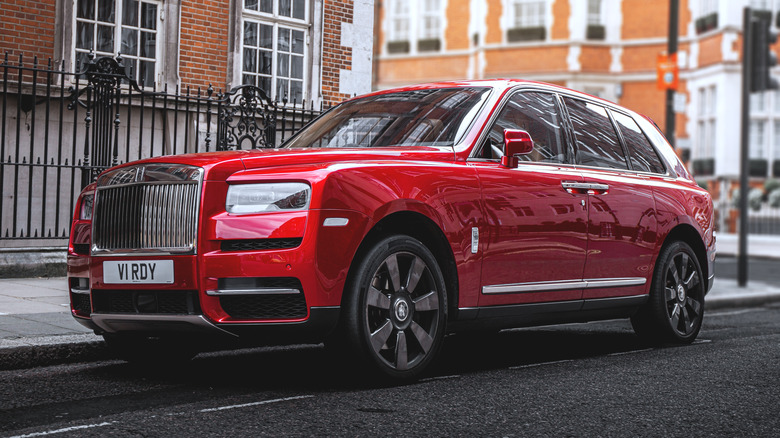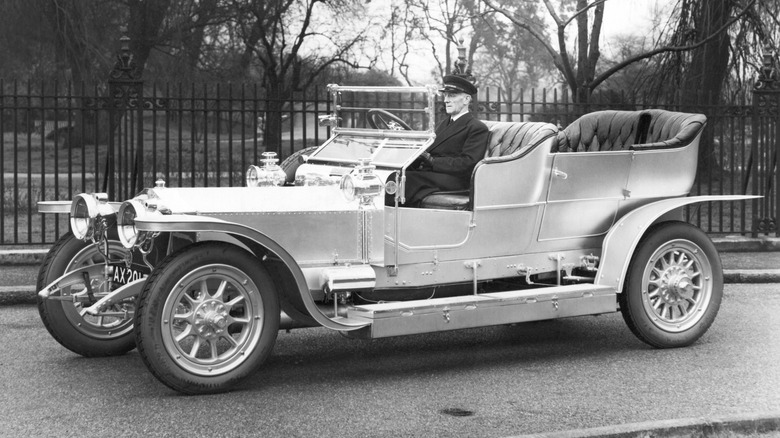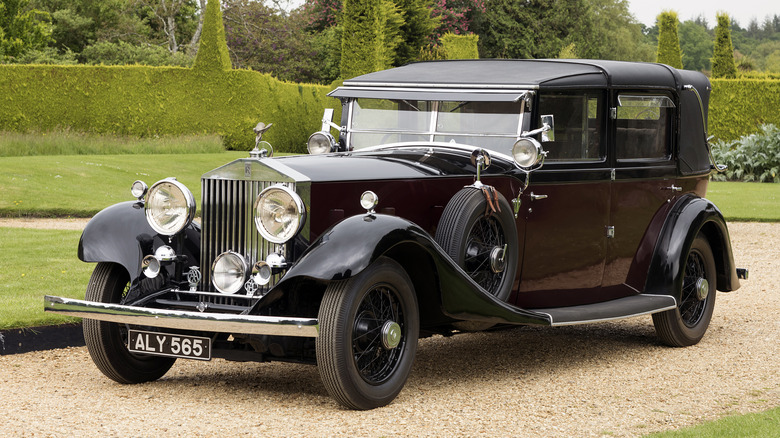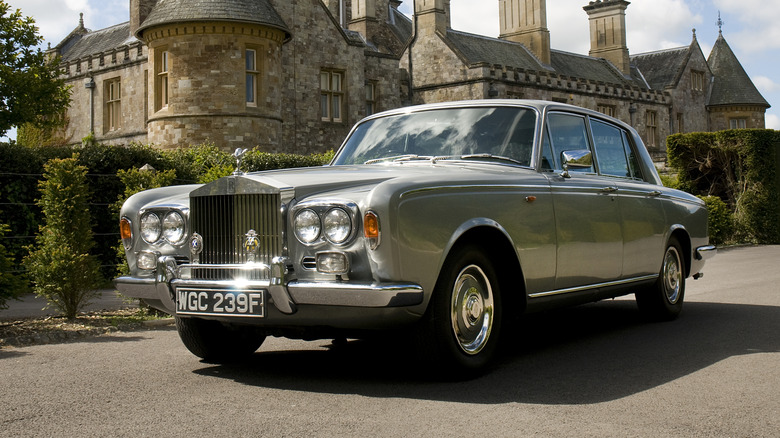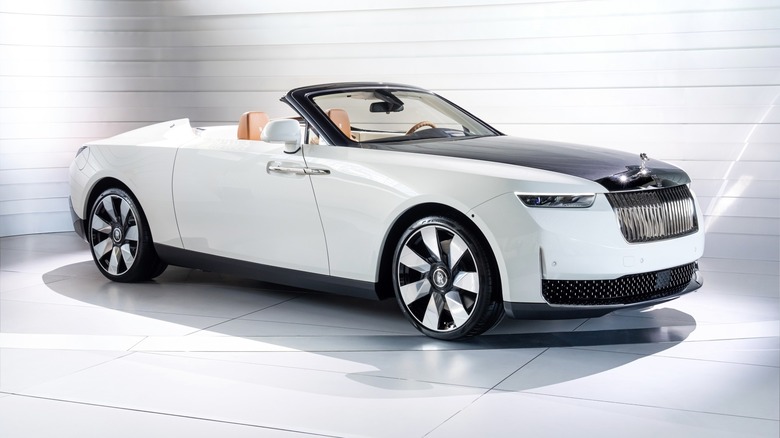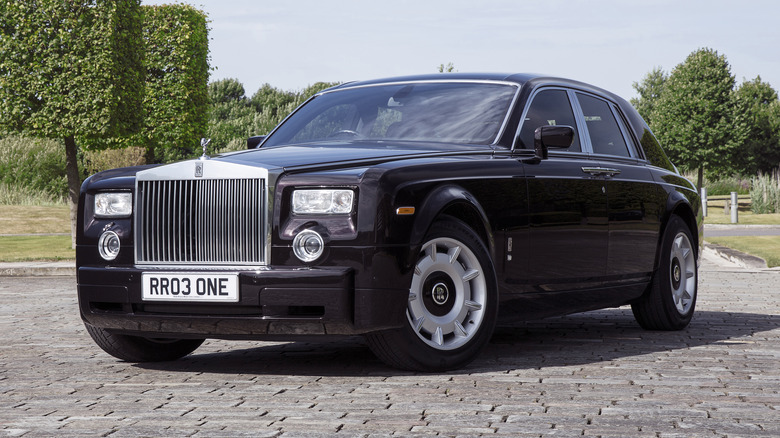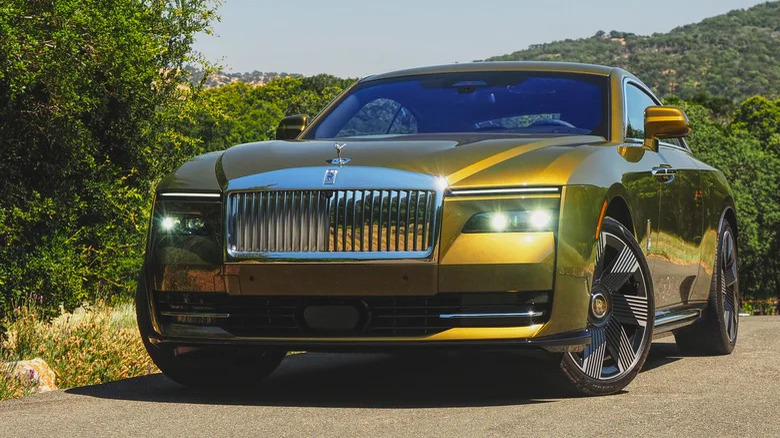The 10 Best Rolls-Royce Models Ever Designed
Ever since Charles Rolls and Henry Royce agreed to form a partnership a century ago, the Rolls-Royce name has represented the very best in luxury carmaking. The company's success has historically hinged on its continued production of world-leading limousines, coupes, and convertibles, all of which remain part of the brand's lineup. However, the launches of the electric Spectre and the Cullinan SUV have proved that Rolls-Royce isn't afraid to venture into new sectors, helping it appeal to new generations of buyers and continue to serve its existing client base.
Although most models in the brand's back catalog are considered influential to some degree, a few stand out from the rest as particularly pivotal in its history. These iconic cars became favorites for many of the world's most wealthy and influential people, from monarchs to rock stars, and continue to be sought after today. The company's designs represented high points for the illustrious carmaker, both in terms of refinement and styling. In turn, they set benchmarks for other luxury carmakers to compete.
Rolls-Royce Phantom I
Perhaps the most instantly recognizable name in the luxury car world other than the Rolls-Royce moniker itself, the Phantom limousine has served as the brand's flagship vehicle for almost 100 years. It was built as an evolution of the 40/50 HP Silver Ghost, the car that had established Rolls-Royce as one of the world's best luxury carmakers, and shared manyparts including its chassis.
However, the 7.7L six-cylinder engine was a new design, created to keep up with the rapidly evolving engine technology of the era. It was a powerful unit — not the fastest of its day, but the smoothest. The focus on quietness and refinement over sheer power is a tradition that Rolls-Royce continues today.
Its status as the original incarnation of the most famous luxury car ever built means that surviving examples are sought after by collectors today, but it wasn't always that way. Automotive technology progressed at an unprecedented rate throughout the '20s, and just four years after the Phantom I's unveiling in 1929, it was replaced by the more technically advanced Phantom II. During the Second World War, many older luxury cars including the Phantom I were stripped down and repurposed as military or agricultural vehicles, leaving only a small fraction surviving to the present day in original condition.
Rolls-Royce 10 HP
Two decades before the first Phantom was unveiled, Sir Henry Royce had already created his first automobile, the 10 HP. The story goes that Royce was heading back from vacation in South Africa when he happened to read a book on the newly emerged automobile industry. Royce's machinery business was struggling at the time and so, despite his limited resources, he decided to pivot to motor car production. He bought a 10 HP Decauville car and disassembled it to determine where it could be improved. Having worked out its weaknesses, he built his own automobile, borrowing not only the Decauville's naming conventions but also a significant proportion of its design.
Royce was introduced to car dealership owner Charles Rolls through a mutual business associate, Henry Edmunds, just a few months after building his first car in 1904. Rolls and Royce quickly agreed to form a partnership: Royce would build cars and sell them exclusively through Rolls' dealership, with the resulting car bearing both of their names. A total of 17 examples of the 10 HP were built, although it's thought that only four of those survive today. One belongs to the Science Museum in London, one is stored in Bentley's Heritage Collection, and the other two are said to be privately owned.
Rolls-Royce Phantom IV
The onset of World War II saw Rolls-Royce abandon its luxury carmaking business and pivot to helping the military effort. In the following years, demand for luxury vehicles remained low, until a request from the British royal family saw the company once again tasked with making a world-beating luxury car. The request came from Elizabeth II, still a princess at the time but positioned to be Britain's future monarch. A suitable state car was needed as her personal transport, and Rolls-Royce unveiled the Phantom IV, the most exclusive Phantom in the line's history. Unlike previous iterations of the car, there was no way to order a Phantom from a dealership or even from Rolls-Royce directly — instead, the company hand-picked to whom it sold each example.
Phantom IV orders were reserved for only those whom the company deemed worthy — primarily world leaders and high-status members of the British royal family — and only 18 examples were built in total. Each one received a custom body from one of Rolls-Royce's coachbuilding partners, meaning no two examples are alike. Remarkably, given its age, it's thought that all but two of the original production run survive to the present day, some still in the collections of various royal families around the world.
Rolls-Royce Cullinan
Building a Rolls-Royce SUV was always going to be a controversial move and one that some purists would likely never approve of. However, spend some time with a Cullinan and it's clear that Rolls-Royce didn't compromise on any aspect of the car. Yes, this is the most off-road capable Rolls-Royce ever built, but it's just as smooth on the road as any of the brand's previous cars. It's also just as luxurious and offers the same near-infinite customizability as the brand's traditional array of limousines, coupes, and convertibles.
It shares an engine, too: a 6.75L V12 to be precise, one that Rolls-Royce has spent many decades perfecting. The Cullinan might be the result of changing market trends, but it still manages to distinguish itself from all other "trendy" SUVs. Almost every manufacturer now has at least one SUV in its lineup, with even the infamously hesitant Ferrari unable to resist the lucrative segment. Yet, no other SUV packs the same level of attention to detail, or offers such a serene driving experience. And so, the Cullinan earns its crown as, quite literally, the Rolls-Royce of SUVs.
Rolls-Royce 40/50 HP Silver Ghost
Keen to build on the success of the 10 HP, a fledgling Rolls-Royce launched a number of more powerful models in its early years, with the top spec variant being the 40/50 HP. It was first unveiled in 1906, just two years after Charles Rolls and Henry Royce had agreed to form a partnership, and would remain in production until 1925. The nickname "Silver Ghost" originally stemmed from one car in particular — the 13th example of the 40/50 HP was finished in a distinctive shade of silver, and was used as a promotional car to demonstrate the quality of Rolls-Royce's products.
It reportedly accumulated 15,000 miles in just its first few months of existence, an unprecedented feat for any publicly sold car at the time. It generated a large amount of publicity, and the public and press began to refer to any 40/50 HP Rolls-Royce as a Silver Ghost. Eventually, the moniker was adopted by the factory. The 40/50 HP helped establish Rolls-Royce as a maker of world-leader cars more than any other model in its early days and proved pivotal both in the brand's history and in the development of luxury cars as a whole. As a result, when surviving examples go under the hammer today, they're extremely highly sought after by collectors, and rank among the brand's most valuable models.
Rolls-Royce Phantom II
Alongside the 40/50 HP Silver Ghost, another of the brand's most valuable cars is the Phantom II. It was unveiled in 1929 and production continued until 1935, during which 1,767 examples were made. The Phantom II design was significantly improved over the original Phantom, with Rolls-Royce overhauling the chassis, engine, and suspension to ensure world-leading performance in every regard. Unlike the Phantom I, the Phantom II focused both on speed and refinement and was considered one of the fastest cars in the world upon its release.
It was designed primarily for high-speed touring across Europe, and so had to not only be fast but also able to sustain that speed over long periods of time. To do that, it had to be reliable. Exceptionally reliable, in fact — no other car of its era could match its build quality. It proved to be even more durable than its successor, the Phantom III, which boasted superior technology but at the cost of being more demanding to maintain.
Like all of Rolls-Royce's cars pre-war, the Phantom II was not available from Rolls-Royce as a turn-key car. Instead, the engine and chassis would be sent to a coachbuilder, which would then build a custom body to the individual customer's liking. As such, no two examples of the Phantom II are exactly the same, with some of the most opulent examples considered to be the most beautiful cars of their time.
Rolls-Royce Silver Shadow
The arrival of the Silver Shadow in 1965 ushered in a new, more modern breed of Rolls-Royce, but in doing so it left behind one of the elements that made the brand's cars unique. It was the first Rolls-Royce to feature a monocoque body, meaning there was no longer any need for a coachbuilder to cloak the car in its own brand of sheet metal. Every car now emerged as finished products directly from Rolls-Royce's factory, effectively killing off the luxury coachbuilding industry, which was already on life support thanks to dwindling interest.
Aside from its monocoque construction, the Silver Shadow also featured new, sharper styling, and suspension borrowed from French carmaker Citroën. Air conditioning and all-around disc brakes were also available for the first time, alongside cruise control. With all these advancements combined with its smooth V8 engine, the Silver Shadow reasserted Rolls-Royce as a leader in luxury cars, becoming the brand's best-selling car in the process. Improvements were continuously made over the car's lifespan, with the Silver Shadow eventually superseded by the Silver Shadow II in 1977.
Rolls-Royce Droptail
While its historic affiliation with third-party coachbuilders remains just that — historic — the automaker has become increasingly keen to show off its in-house coachbuilding ability in recent years. Nowhere is that demonstrated more succinctly than in the case of the Droptail, which is not only the most expensive Rolls-Royce ever built, but also one of the most unique. It was originally conceived at the request of a handful of VIP clients, with a limited run of just four cars planned to be built.
Three out of four cars have been unveiled as of this writing, with the most recent being the Arcadia Droptail. Like the other examples in the series, it was built specifically to its owner's wishes and features many bespoke design elements that can't be found on the brand's other cars. For example, it features a clock that Rolls-Royce says is the "most complex clock face in [its] history," with its assembly alone reportedly taking five months to complete. The car also features 233 pieces of wood trim, each individually machined.
Calling the Droptail exclusive would be an understatement. The program was only open to the brand's most loyal customers, and not publicly disclosed until each car's recipient had already been chosen. Exact prices haven't been confirmed by Rolls-Royce, but reports have pegged each Droptail at around $30 million — an even more eye-watering sum than previous one-off specials like the Boat Tail and Sweptail.
Rolls-Royce Phantom VII
The Phantom VII was developed at a pivotal time for Rolls-Royce. The late '90s saw two German heavyweights, BMW and VW, fight over the rights to the marque. BMW eventually emerged victorious, with VW effectively forced to surrender the Rolls-Royce name from 2003, despite owning the brand's historic factory and many of its assets. The VW-owned remains of the original Rolls-Royce company would be restructured and continue selling cars under the Bentley marque, while the pressure was on BMW to deliver a world-beating flagship model to kickstart this new chapter of Rolls-Royce's history.
The seventh-generation Phantom was unveiled in 2003, and more than delivered on its brief. It was all-new from the ground up, with every aspect of the car from its aluminum chassis to its 6.75L V12 engine thoroughly reworked. The sixth-generation Phantom was launched in 1968 and was already ancient by the time it was retired in 1990. Its successor was a world away in terms of technology, yet it still managed to convey the dignified, regal look of previous iterations. It remained in production for 13 years and spearheaded Rolls-Royce's resurrection under its new ownership.
Rolls-Royce Spectre
Much like the seventh-generation Phantom, the Spectre represents a significant milestone in Rolls-Royce's history. It was unveiled in 2022 as the indirect successor to the Wraith, taking the Wraith's place in the lineup as the brand's signature two-door, driver-oriented offering. The headline feature, of course, is that the Spectre is the brand's first electric car, but Rolls-Royce has been careful to play down that element as much as possible. Per the brand's press release, "it is a Rolls-Royce first and an electric car second."
Take the Spectre for a drive and it's easy to see what that statement means. The car is very much a stereotypical Rolls-Royce in most regards — it looks grand and imposing, features the brand's famous magic carpet ride, and offers a litany of bespoke options to ensure that every example is unique. It just so happens to be electric, but with the brand's prior fixation on cabin quietness and smooth acceleration, it's not like the new powertrain delivers any significantly different experience to other models. In many cases, cars are considered design triumphs because they add something new and unique to the ownership experience. The Spectre is such a triumph for precisely the opposite reason. It represents Rolls-Royce's single biggest powertrain change since the brand was founded, yet it doesn't change the Rolls-Royce experience one bit.
